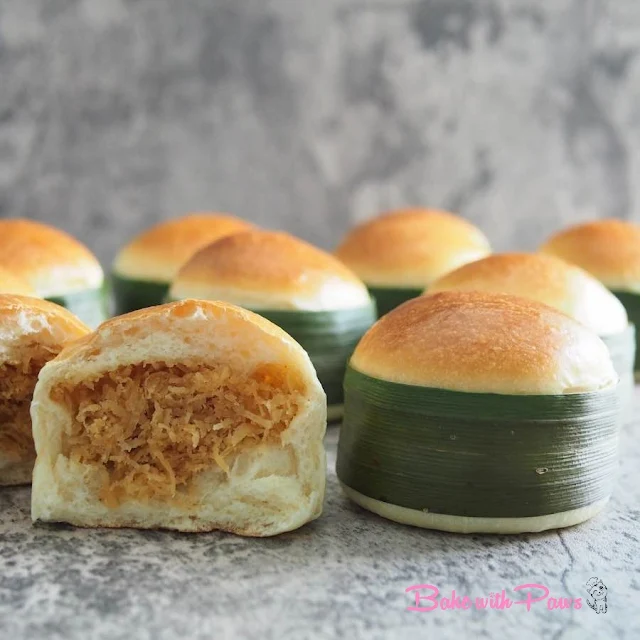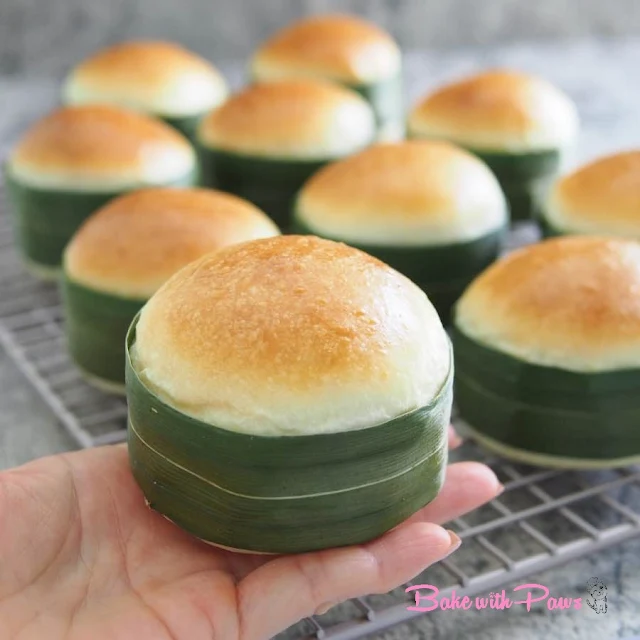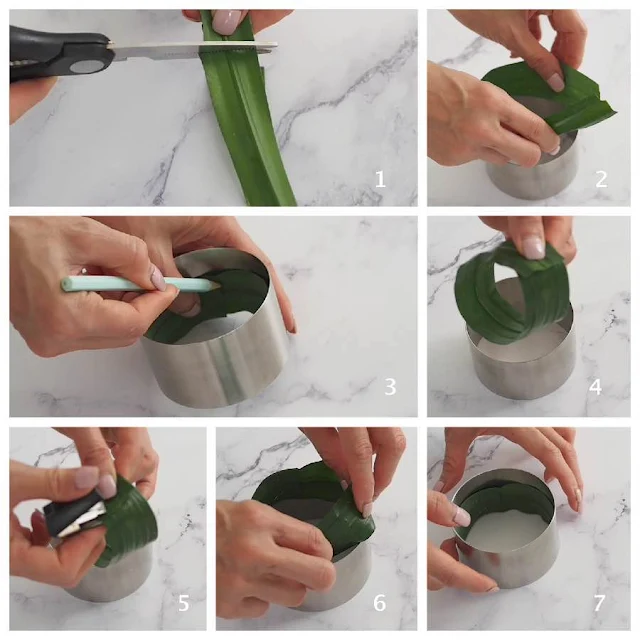Breads (Sourdough) - Soft Buns/Rolls
Coconut Buns (Sourdough)
April 07, 2023
| Recipe by Bake with Paws
Scroll to the bottom of the page for "PRINT RECIPE" ⬇
Coconut Buns are very popular in Malaysia. They are soft and fluffy buns stuffed with freshly shredded coconut cooked with gula Melaka (palm sugar) syrup. This is a bun that really takes me back to my school days. It was something we could always find in our school canteen.
I made these Coconut Buns with sourdough and used less sugar in the coconut filling. The texture is soft and fluffy and the filling is not too sweet. This is perfect for my family's taste.
If you don't have sourdough starter, please click Pandan Coconut Buns for the instant yeast version.
If you have any questions regarding this recipe or any other post, please leave me a comment in the “LEAVE A COMMENT” link and I will reply you as soon as possible. Do tag me on Instagram @Bakewithpaws if you attempt on this.
How To Make Coconut Buns (Sourdough)
INGREDIENTS:
Yudane Dough:
70g bread flour (I used Japan High Gluten Flour)
70g boiling water
Sweet Stiff Starter:
60g sourdough starter (100% Hydration), preferably use at its peak
180g bread flour (I used Japan High Gluten Flour)
75g water or 90g milk
30g sugar (I used organic brown sugar)
Main Dough:
70g bread flour (I used Japan High Gluten Flour)
All stiff starter (above)
All the yudane dough (above)
15g brown sugar (I used organic brown sugar)
1 tsp salt
20g milk powder (omit if SST is fed with milk)
15g water, cold (reserve half and add in all if needed)
45g cold egg, whisked (from 1 medium egg)
35g butter, room temperature
Egg Wash:
1 egg + 1 tbsp water, whisked
Gula Melaka Coconut Filling: (Please click here for Pandan Coconut Filling)
250g grated fresh coconut (only the white part)
50g - 80g palm sugar (gula melaka), please add more if you prefer sweeter.
Pinch of salt
Pinch of salt
200g water
2 tsp corn starch + 2 Tbsp water
4 pandan leaves, cut into about 4 inches length
Utensil:
Baking tray
10 units of Round Mould Ring (8 cm diameter X 5 cm height)
10 pandan leaves
METHOD:
- Gula Melaka Coconut Filing:
- Combine palm sugar, water and pandan leaves in a sauce pan. Boil till sugar dissolved.
- Discard the pandan leaves. Sieve the syrup to remove any impurities.
- Add in grated coconut and salt. Stir well then add in corn starch mixture.
- Cook over medium heat till the coconut is cooked and until turn slightly dry. Stir constantly to prevent burning.
- Dish out and set aside to cool.
- Divide the filling into 10 portions and and roughly roll into balls weighing 30g each. You may have some balance.
- Yudane:
- Add bread flour in a bowl, pour the boiling water and mix well with spatula or spoon until no dry flour.
- Cling film and leave on the counter for at least 4 hours or overnight in the fridge. I prepared the night before.
- Use directly from the fridge.
- Sweet Stiff Starter
- Dilute starter with water, stir in sugar and mix in bread flour to become a dough. Please use stand mixer with paddle attachment to mix if you find hard to mix with hand.
- Cover and let it ferment until tripled. I prepared a night before and leave it in aircond room (approximately 24 - 25C room temperature) overnight until tripled. It took about 8 - 9 hours depending on your starter. It should take around 4 - 6 hours to get triple at room temperature at 28C - 30C. The starter should look smooth and round dome. It shouldn't collapse.
- Prepare Round Mould Ring:
- Trim the pandan leaves.
- Make a ring same size as the mould.
- Staple both ends together with a stapler.
- Line the side of each mould ring with pandan leaves.
- Main Dough:
- Put all ingredients (except butter), including all the stiff starter and yudane dough into a bowl of stand mixer.
- Slightly combine the mixture by hand with the paddle attachment before turning on the machine so that the flour will not splash out. Using the paddle attachment, mix for 2 minutes or until all incorporated. This step is critical to prevent an uneven mixed dough as the stiff starter is rather hard and a dough hook may not be able to mix it well enough.
- Change to hook attachment and knead for another 3 minutes or until the dough comes together. Add in butter and continue knead for 10 - 12 minutes or until reach window pane stage. The whole kneading process, I stopped few times to scrape down the dough from the hook to be sure it is evenly kneaded and also to prevent the motor from overheating.
- 1st Proofing/Resting:
- In the same bowl, let the dough rest for 45 - 60 minutes. Keep it covered with clingfilm or use a lid. This dough I rested for 45 minutes and the dough rose slightly in 45 minutes.
- Shaping:
- Transfer the dough to a clean surface slightly dusted with flour, divide dough into 10 equal portions (approx.65.5g each). Please use a kitchen scale if you want to be exact.
- Shape each dough into a ball and rest for around 15 minutes.
- Roll a dough ball into a disc, the edges slightly thinner than the centre.
- Place a coconut filling ball in the centre. Gather up the edges to seal and shape into round ball.
- Place the buns on the lined baking tray.
- Place the prepared mould ring on each bun.
- Final Proofing:
- Let the buns proof at a warm place until the dough rise double in size. This one took approximately 2 hours at at room temperature of 29C - 30C. The duration of proofing depends on your ambient temperature and starter.
- Baking:
- Preheat oven at 190C - 200C (top & bottom heat) or 180C (fan-forced) for 10 - 15 minutes.
- Brush with egg wash.
- Bake in a preheated oven for 15 - 20 minutes, or until golden brown.
- Remove bread from oven and let them cool on rack.
Coconut Filling
Yudane Dough
Sweet Stiff Starter
Lined The Mould Ring
Main Dough
GENERAL NOTES:
SOURDOUGH STARTER
Please click this link for "How To Make Sourdough Starter" and "Sourdough Maintenance"
A healthy starter is very crucial as advised by Baking with Gina. It is advisable to feed your starter regularly if you want your bread to rise nicely and to use the starter (levain) at its peak. A starter that is fed regularly will be more active in general. If the mother starter is not strong, the bread dough will not rise a lot even though the starter is used at its peak.
GLUTEN DEVELOPMENT & WINDOWPANE TEST
Gluten forms when flour comes in contact with water. Hydration of the flour causes the sticky and stretchy protein to form, giving structure to the bread. This makes your bread trap air and rise.
Gluten in dough can be developed by autolyse, resting, kneading or folding.
The windowpane test is used to determine whether the dough has been sufficiently kneaded. By gently pulling the dough (or you may pinch off some dough) and trying to stretch it into a thin membrane. If you are able to stretch the dough paper thin and translucent without tearing, then the gluten is fully developed. However, if you can stretch it without tearing but the membrane is not transparent, then the gluten is not yet fully developed.
However, from my experience not all the recipe can achieve a thin and translucent window pane stage easily. For example low hydration and low fat dough. For such recipes, a reasonable window pane is good enough and it can be left to rest. Gluten will continue to develop while resting. Exercising restraint to not over-knead the dough prevents the gluten from being overworked and broken. Some of you may have experienced the dough breaking during the second proofing. It is because the dough is over kneaded.
The total kneading time for me is usually 15 minutes at low speeds except brioche dough with high fat percentage or dough using liquid fat which usually takes a little longer (maybe 18-20 mins).
From my experience, I found that high hydration dough with high percentage of fat will be easy to stretch and achieve a paper thin windowpane stage.
KNEADING TIME
For kneading, please regard the timing provided as an indication only. It is only meant as a guide. Timing may differ depending on the brand of flour and electric mixer used. The protein content may vary from one brand of flour to another.
FLOUR
The right flour plays a very important role in bread making. To achieve fluffy, soft and light bread, I used Japan High Gluten Flour in most of my bread baking. The protein content is around 12 - 13%.
HYDRATION
The liquid measurement given is also a guide. It is advisable to always reserve some liquid and not add it all in one go. This would give you the opportunity to adjust if necessary. If dough is too dry, add the reserve liquid one tablespoon at a time until the right consistency. This is because each flour absorbs water and hydrates differently.
PROOFING
Please note that the proofing timing may also vary depending on your climate, environment, flour and your starter.
If you are unable to judge by just looking at the dough, you can do the finger poke test:
- Lightly press the side of the proved dough with your finger. If it bounces back immediately without any indentation, it means the dough is under proved and needs more time before baking.
- If the indentation stays and it doesn’t bounce back, it means it has been over proved.
- If the indentation slowly bounces back and leave a small indentation, it is ready to bake.
- There will be a final burst of rising once the bread is placed to bake in the oven and it is called oven spring.
If your bread collapses or gets wrinkled on top after removing from oven, it could be because your dough over proved during the second proofing. Please proof until the tip of the dough just reaches the rim of the pan, around 80% - 90% in size.
BAKING TEMPERATURE AND TIME
Do also note that the baking temperature and timing provided are what works for my oven and should also be regarded as a guide only. Every oven behaves a little differently, so please adjust accordingly for your oven.
Labels:
Breads (Sourdough) - Soft Buns/Rolls,










Such a unique way to bake the buns! May I know where you bought the round mould rings from please?
ReplyDeleteHi, thank you for visiting Bake with Paws. I ordered online from Shoppee.
DeleteCheers :)